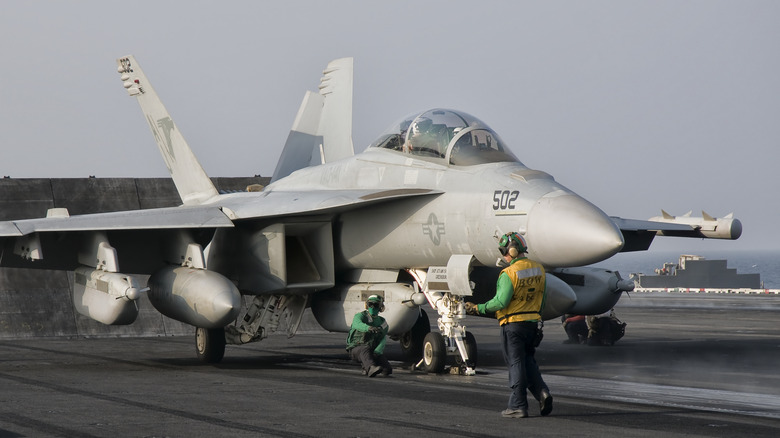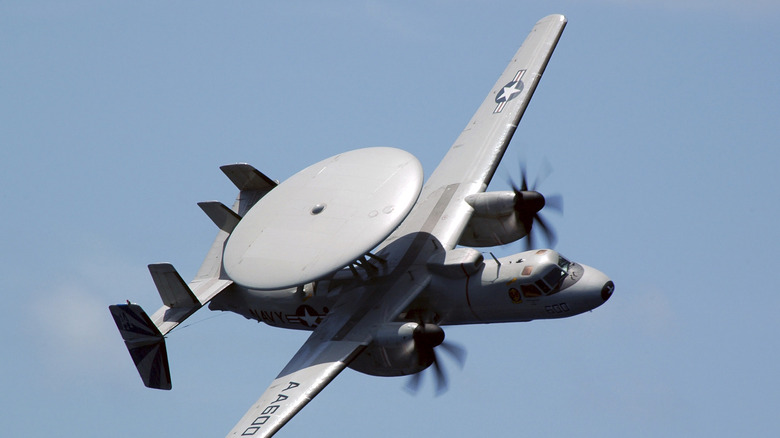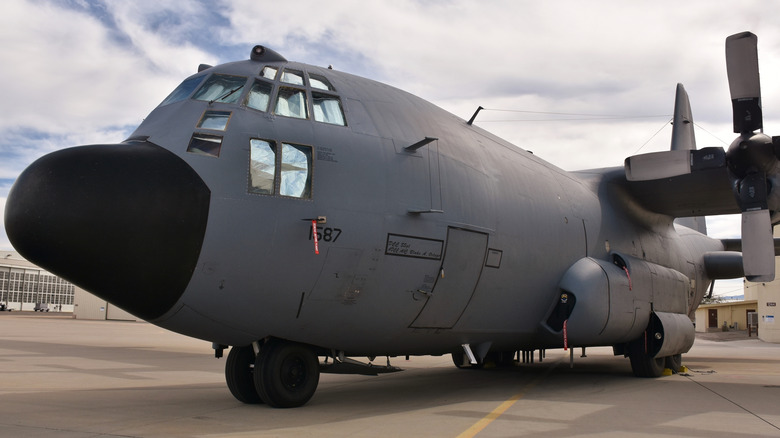What Are Electronic Warfare Aircraft And How Do They Work?
When you're a science fiction fan, whether it's books or cinema, you hear things like "Jam their communications" or "Boost our signal," and think it would be so cool if that kind of technology were real. Well, sometimes the real world either catches up with fiction or those concepts are based on real-world tools. The military has access to a variety of aircraft specifically designed to engage in a tactic known as Electronic Warfare (EW).
Electronic Warfare, as defined by Lockheed Martin, "represents the ability to use the electromagnetic spectrum—signals such as radio, infrared, or radar—to sense, protect, and communicate. At the same time, EW can disrupt, deny and degrade the adversaries' ability to use these signals." This gives forces an edge on the battlefield, increasing the chances for a successful mission. The U.S. military uses a variety of aircraft to engage in electronic warfare. The Navy's most advanced airborne electronic attack (AEA) platform is the EA-18G Growler, which is a variant of the F/A-18F Super Hornet.
The biggest difference is the lack of the Super Hornet's internal 20mm cannon. Instead, Boeing outfitted the Growler with electronic warfare equipment, and if it needs more than that, additional EW equipment can be attached to any of its nine hardpoints. However, even the U.S. Army's famed AH-64E Apache Guardian helicopter is equipped with EW tools, containing a powerful targeting system and a superior Radar Warning Receiver (RWR) known as the AN/APR-48B Modernized Radar Frequency Interferometer (MRFI).
How Electronic Warfare works
Electronic Warfare comes in a variety of shapes and forms, including support, protection, and attack. Electronic Support (ES) improves the operational capacity of radar systems not only to detect enemies at greater range but also to help distinguish between friendly forces and the enemy, allowing allies to properly prepare for upcoming operations. The Gulf War saw the most significant air campaign since World War II, and it was because of ES that so much of it was successful for America and its allies. Airborne Early Warning and Control (AWACS) provided essential intelligence for both troops on the ground and in the air during Operation Desert Storm.
When a group needs to go on the offensive, there are Electronic Attack (EA) tactics at their disposal. This is the use of electromagnetic tools that will disrupt an enemy's electronic infrastructure. An EA-18G Growler, though it looks like an F/A-18 Super Hornet, is equipped with specialized EW equipment that can jam enemy radar by flooding radio frequencies with noise or false information. How close does a Growler need to get to disrupt enemy equipment? It's unknown as Boeing, the Navy, and Defense Department keep those details close to the chest for national security.
Aircraft specifically designed for electronic warfare
Both BAE Systems and Northrop Grumman are responsible for developing EW equipment for a number of platforms in the US military, including the Air Force's F-15, F-16, F-22, F-35, the Army's UH-60 Blackhawk and AH-64 Apache, as well as the Navy's EA-18G Growler. It's Northrop that provides Electronic Protection to the F-16 with its AN/ALQ-257 Integrated Viper Electronic Warfare Suite (IVEWS). The EA-18G Growler is the latest in electronic warfare aircraft since its predecessor, the EA-6B Prowler.
To give an idea about how crucial Electronic Warfare has been for the military, the Navy states, "Navy EA-6B Prowlers determined threat location then jammed and destroyed enemy radars. Navy defense suppression aircraft supported all U.S. and coalition forces — in fact, availability of the EA-6Bs was a go/no-go criterion for many strike missions. If Navy defense suppression wasn't available, the missions didn't fly." The EA-6B Prowler was a vital component for success during Operation Desert Storm, and the EW, in general, continues to be a crucial tactic employed in campaigns across the globe.
The Air Force, on the other hand, has modified a C-130 Hercules to create its own electronic attack aircraft known as the EC-130 Compass Call. The EC-130H Compass Call holds a crew of 13 where nine of the members operate the EA equipment developed by BAE Systems and built into the plane's mission compartment. This C-130 variant isn't only capable of blocking communication, it can also provide Early Warning/Acquisition radar.


